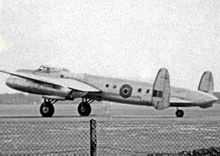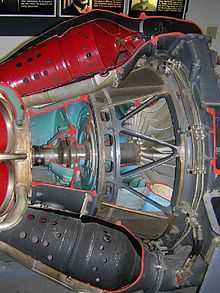Rolls-Royce Nene
| RB.41 Nene | |
|---|---|
 | |
| Rolls-Royce Nene on display at RAAF Base Pearce, Western Australia - note the wire mesh grille around the air intake to prevent Foreign object damage | |
| Type | Turbojet |
| Manufacturer | Rolls-Royce Limited |
| First run | 27 October 1944 |
| Major applications | Canadair CT-133 Silver Star Dassault Ouragan de Havilland Vampire Grumman F9F Panther Hawker Sea Hawk |
| Number built | 1,139 (J42) |
| Developed into | Rolls-Royce RB.44 Tay Klimov VK-1 Rolls-Royce Derwent |
The Rolls-Royce RB.41 Nene is a 1940s British centrifugal compressor turbojet engine. The Nene was essentially an enlarged version of the Rolls-Royce Derwent with the minimal changes needed to deliver 5,000 lbf, making it the most powerful engine of its era. The Nene was Rolls-Royce's third jet engine to enter production, designed and built in an astonishingly short five-month period in 1944, first running on 27 October 1944.[1] It was named after the River Nene in keeping with the company's tradition of naming its jet engines after rivers.
The design saw relatively little use in British aircraft designs, being passed over in favour of the axial-flow Avon that followed it. Its only widespread use in the UK was in the Hawker Sea Hawk and the Supermarine Attacker. In the US it was built under licence as the Pratt & Whitney J42, and it powered the Grumman F9F Panther. Its most widespread use was in the form of the Klimov RD-45, which powered the famous Mikoyan-Gurevich MiG-15.
A more powerful sightly enlarged version of the Nene was produced as the Rolls-Royce Tay.
Design and development

The Nene was designed and built as a result of an early 1944 Air Ministry request for an engine of 4,200 lb thrust, and an engine was schemed-out by Stanley Hooker and Adrian Lombard as the B.40. In the summer of 1944 Hooker visited the USA and discovered that General Electric already had two engine types of 4,000 lb thrust running. On returning to the UK Hooker decided to go for 5,000 lb of thrust, and working with Lombard the B.40 was transformed into the B.41, later to be called the Nene.
Based on the B.40, the impeller was enlarged to 28.8 inches to handle an airflow of 80 lb/sec, while the overall diameter of the engine was reduced to 49.5 inches. Other features were incorporated from Derwent testing, with a Type 16 compressor casing, and nine individual combustion chambers developed by Lucas, and the resulting B.41 prototype was built within six weeks, and was ready for its first run on 27 October 1944. A number of snags delayed the run until nearly midnight, when with almost the entire day and night shift staff watching, an attempt was made to start the engine, without the inlet vanes, which had not yet been fitted. To everyone's dismay the engine refused to light - positioning the lighter was a trial-and-error affair at the time. On the next attempt, Denis Drew unscrewed the igniter and as the engine ran up to speed, lit the engine with an oxy-acetylene torch. The engine was run up to 4,000 lb and more, and a cheer went up around the assembled personnel. Upon Hooker's arrival next morning, and informed that the inlet vanes had been fitted during the night, Hooker was satisfied to see the thrust gauge needle registering 5,000 lb, making the B.41 the most powerful jet engine in the world. Weight was around 1,600 lb[2]
Although based on the "straight-through" version of the basic Whittle-style layout, the Nene used a double-sided centrifugal compressor for improved pressure ratio and thus higher thrust. It was during the design of the Nene that Rolls decided to give their engines numbers as well as names, with the Welland and Derwent keeping their original Rover models, B/23 and B/26. It was later decided that these model numbers looked too much like those for bombers, and "R" was added to the front, the "R" signifying "Rolls" and the original Rover "B" signifying Barnoldswick. This RB designation scheme continues to this day.
Early airborne tests of the Nene were undertaken in an Avro Lancastrian operated by Rolls-Royce from their Hucknall airfield. The two outboard Rolls-Royce Merlins were replaced by the jet engine. The Nene's first flight however was in a modified Lockheed XP-80 Shooting Star.[3]
After seeing the Nene running, at an after work drink at the Swan & Royal Hotel, Clitheroe, and hearing the complaints about a lack of any official application for the engine, someone - thought to be Whittle - suggested that the Nene be scaled-down to fit a Meteor nacelle. J.P. Herriot or Lombard did the calculation on a tablecloth and announced a thrust of 3,650 lb. At this time they were attempting to increase the Derwent's thrust from 2,200 lb to 2,450 lb, and the idea seemed "too good to be true". On hearing this, Hooker did a quick calculation and announced, "We've got a 600-mph Meteor".[4]
Drawings for the 0.855 scale Nene, now known as the Derwent V, were started on 1 January 1945 and on the 7th June the engine began a 100-hour test at 2,600 lb, soon reaching 3,500 lb. Weight was 1,250 lb. By 1946 thrust had been increased to 4,200 lb using Nimonic 90 turbine blades.[4]
The development of the Nene was continued with this scaled-down version, the Derwent V having no direct relationship to the earlier Derwent series. On 7 November 1945, the first official air speed record by a jet aircraft was set by a Meteor F.3 of 606 miles per hour (975 km/h) powered by the scaled-down Nene, the Derwent V
Service use

The Nene doubled the thrust of the earlier generation engines, with early versions providing about 5,000 lbf (22.2 kN), but remained generally similar in most ways. This should have suggested that it would be widely used in various designs, but the Gloster Meteor proved so successful with its Derwents that the Air Ministry felt there was no pressing need to improve upon it. Instead a series of much more capable designs using the Rolls-Royce Avon were studied, and the Nene generally languished.
The Nene was used to power the first civil jet aircraft,[5] a modified Vickers Viking, which flew first on 6 April 1948.[5]
Pratt and Whitney was given a licence to produce the Nene as the Pratt & Whitney J42, and it powered the Grumman F9F Panther.[6] Twenty-five were given to the Soviet Union as a gesture of goodwill - with reservation to not use for military purposes - with the agreement of Stafford Cripps. The Soviets reneged on the deal, and reverse engineered the Nene to develop the Klimov RD-45, and a larger version, the Klimov VK-1, which soon appeared in various Soviet fighters including Mikoyan-Gurevich MiG-15. It was briefly made under licence in Australia for use in the RAAF de Havilland Vampire fighters. It was also built by Orenda in Canada for use in 656 Canadair CT-133 Silver Star aircraft.
Variants
- Nene Mk.3
- With an electric starter motor and two torch igniters the Mk.3 powered the Supermarine Attacker F Mk.1.
- Nene Mk.10
- Similar to the Mk.102 but with a larger accessories wheelcase for the Lockheed T-33.
- Nene Mk.101
- With a bi-furcated jet-pipe for the Hawker Sea Hawk, at a reduced output of 5,000 lbf (22.24 kN)
- Nene Mk.102
- Similar to the Mk.3, but incorporating more modern equipment, for the Supermarine Attacker FB Mk.2
Applications
- Nene
- Armstrong Whitworth AW.52
- Avro Ashton
- Avro Lancastrian (test-bed)
- Avro Tudor VIII
- Boulton Paul P.111
- Boulton Paul P.120
- Canadair CT-133 Silver Star
- Dassault Ouragan
- de Havilland Vampire
- FMA IAe 33 Pulqui II
- Gloster E.1/44
- Handley Page HP.88
- Hawker P.1052
- Hawker P.1081
- Hawker Sea Hawk
- Nord 2200
- Rolls-Royce Thrust Measuring Rig
- SNCAC NC.1071
- SNCAC NC 1080
- SNCASO SO.4000
- SNCASO SO.6000 Triton
- Sud-Est Grognard
- Sud-Ouest Bretagne
- Sud-Ouest Triton
- Supermarine Attacker
- Vickers Type 618 Nene-Viking
- Pratt & Whitney J42
Engines on display
A sectioned Rolls-Royce Nene is on display at the Fleet Air Arm Museum, RNAS Yeovilton.
- Gatwick Aviation Museum Charlwood surrey
- Rolls-Royce Nene
There is a cutaway Nene II on display at the New England Air Museum
A sectioned Hispano-Suiza Nene is on display at the Ailes Anciennes Toulouse Museum in France.
- Ailes Anciennes Toulouse Museum Toulouse/Blagnac
A DERWENT ( from Meteors and PULQUI I) , a NENE ( from the PULQUI II) and two Avon s ( 1 from Canberra and one from a Comet) are on display at the National Aeronautics Museum- Moron- Buenos Aires - Argentina
Specifications (Nene)

Data from [7]
General characteristics
- Type: Centrifugal compressor turbojet
- Length: 96.8 in (2,458.7 mm)
- Diameter: 49.5 in (1,257.3 mm)
- Dry weight: 1,600 lb (725.7 kg)
Components
- Compressor: 1-stage double-sided centrifugal compressor
- Combustors: 9 x can combustion chambers
- Turbine: Single-stage axial
- Fuel type: Kerosene (R.D.E.F./F/KER)
- Oil system: pressure feed, dry sump with scavenge, cooling and filtration, oil grade 70 S.U. secs (13 cs) (D.T.D 44D) at 38 °C (100 °F)
Performance
- Maximum thrust: 5,000 lbf (22.24 kN) at 12,300 rpm at sea level for take=off
- Specific fuel consumption: 1.06 lb/lbf/hr (108.04 kg/kN/hr)
- Thrust-to-weight ratio: 3.226 lbf/lb (0.0315 kN/kg)
- Military, static: 5,000 lbf (22.24 kN) at 12,300 rpm at sea level
- Max. cruising, static: 4,360 lbf (19.39 kN) at 12,000 rpm at sea level
- Cruising, static: 3,620 lbf (16.10 kN) at 11,500 rpm at sea level
- Idling, static: 120 lbf (0.53 kN) at 2,500 rpm at sea level
See also
- Related development
- Related lists
References
- Notes
- ↑ Bingham 2004, pages 96-100
- ↑ "World Encyclopedia of Aero Engines - 5th edition" by Bill Gunston, Sutton Publishing, 2006, p.193
- ↑ http://www.flightglobal.com/pdfarchive/view/1946/1946%20-%200764.html
- ↑ 4.0 4.1 "World Encyclopedia of Aero Engines - 5th edition" by Bill Gunston, Sutton Publishing, 2006, p.194
- ↑ 5.0 5.1 http://www.flightglobal.com/pdfarchive/view/1949/1949%20-%200401.html
- ↑ Connors, p.202
- ↑ Wilkinson, Paul H. (1946). Aircraft Engines of the world 1946. London: Sir Isaac Pitman & Sons. pp. 298–299.
- Bibliography
- Wilkinson, Paul H. (1946). Aircraft Engines of the world 1946. London: Sir Isaac Pitman & Sons. pp. 298–299.
- Bingham, Victor (2004). Supermarine Fighter Aircraft. The Crowood Press. ISBN 1-86126-649-9.
- Bridgman, L, (ed.) (1998) Jane's fighting aircraft of World War II. Crescent. ISBN 0-517-67964-7
- Connors, Jack (2010). The Engines of Pratt & Whitney: A Technical History. Reston. Virginia: American Institute of Aeronautics and Astronautics. ISBN 978-1-60086-711-8.
- Kay, Anthony L. (2007). Turbojet History and Development 1930-1960 1 (1st ed.). Ramsbury: The Crowood Press. ISBN 978-1-86126-912-6.
External links
| Wikimedia Commons has media related to Rolls-Royce Nene. |
- Pratt & Whitney History page on the J42
- The Nanton Lancaster Society
- "Rolls-Royce Nene I" a 1946 Flight article on the Nene
| ||||||||||||||||||||||||||||||||||||||||||||||
| ||||||||||||||
| ||||||||||||||||||||||